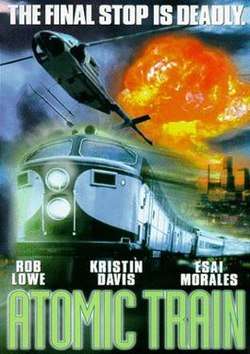Atomic Train
Atomic Train is a 1999 American made-for-television disaster-action-thriller film about an accidental nuclear explosion destroying the city of Denver. It was originally broadcast on NBC as a two-part miniseries on May 16 and 17, 1999.
| Atomic Train | |
|---|---|
 Theatrical release poster | |
| Genre | Disaster Thriller Action |
| Written by | Jeff Fazio |
| Directed by | David Jackson Dick Lowry |
| Starring | Rob Lowe Kristin Davis Esai Morales John Finn Mena Suvari |
| Theme music composer | Lee Holdridge |
| Country of origin | USA |
| Original language(s) | English |
| Production | |
| Running time | 168 minutes |
| Distributor | Trimark Home Video (DVD) |
| Release | |
| Original network | NBC |
| Original release | May 16 – 17, 1999 |
Plot
Bradshaw Disposal Services has a nuclear bomb made in Russia to transport, and an employee (named Henry Bradshaw) decides to save money by concealing it on a freight train. This train is also loaded with hazardous and flammable chemicals, including metallic sodium, which spontaneously ignites on contact with water. The train suffers a brake failure and becomes a runaway heading for Denver. John Seger, a National Transportation Safety Board (NTSB) investigator, boards the train and with the assistance of the railwaymen tries various ways to stop the train. Several ideas are tried, such as coupling a following train to the caboose (the coupling mechanism on the caboose breaks, which also results in the death of one of the train's crew members), a derailing attempt (after it is revealed the catastrophe the chemicals would cause if ignited) in which a helicopter narrowly avoids being hit, and finally, an attempt at manually activating the brakes (via hitting a part of the engine mechanism with a wrench). The final attempt works successfully but is short-lived. The following rescue train, unaware of the freight's slowing, speeds forward and crushes the caboose (killing an injured crew member in the process). The force disengages the brakes, this time for good, causing the train to speed up once again. Meanwhile, Denver residents are struggling to collect their families and then leave town, despite rioters, looters, and gridlock. Realizing that there is no way to stop it, John and the engineer (who was initially reluctant) abandon the train by jumping off before it can speed up too much.
The train derails and becomes a terrific wreck. Discovering the now highly unstable bomb on board, firefighters struggle to extinguish the fire at the crash site. After realizing that metallic sodium is on the train, the firefighters and NEST teams retreat to evaluate a strategy. In the meantime, all firefighting aircraft are grounded. The misinterpretation of a radio call to a water bombing helicopter leads it to dump its load of water onto the wreck. Water comes into contact with the metallic sodium, which explodes and in turn causes the nuclear bomb to detonate. The blast causes severe damage throughout Denver and releases an electromagnetic pulse. No cars work, electricity is down and anything with a computer is shut down.
After the blast, Denver lies in ruins. John (who made it back to town via helicopter) then attempts to get his family out of Denver before nuclear fallout starts. After finding a working car, John eventually reunites with his family at a FEMA refugee camp in Eminence, Kansas.
Cast
- Rob Lowe as John Seger
- Kristin Davis as Megan Seger
- Esai Morales as Noris 'Mac' MacKenzie
- John Finn as Wally Phister
- Mena Suvari as Grace Seger
- Edward Herrmann as President Fellwick
Awards
- Won the Golden Reel Award (2000) for "Best Sound Editing - Television Mini-Series - Effects and Foley"
- Nominated for Golden Reel Award (2000) for "Best Sound Editing - Television Mini-Series - Dialogue and ADR"